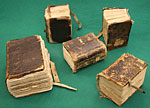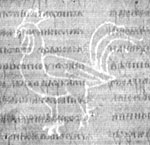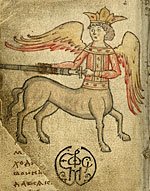Euphrosynus Manuscripts
The five Euphrosynus miscellanies are typical examples of manuscripts intended for a private reading in a modest monastic cell. The four of them are small portable books that are easy to carry. They are called octavo volumes (format "in eighth"). These are personal books which were compiled by Euphrosynus for himself. One book is a large volume in quarto format (format "in fourth"). It apparently was intended for Hegumen Ignatius, the head of the Kirillo-Belozersky Monastery (St. Cyril of Beloozero's Monastery).All the books are quite thick and covered with leather bindings, they resemble closely compacted blocks. Looking at them you understand their compiler did not lack for literary material.
Euphrosynus' Handwriting and Notes
The manuscripts were copied by several scribes, in small hands. The words are written close together with almost no space between letters. Paper was expensive and the copyists tryied to write as many words on a line as they could. The lager portion of the manuscripts is written in the same distinctive and easily recognizable style. This hand is attributed to Euphrosynus who has included in the books not only texts written by his own hand, but also the works of other scribes. But the "somebody else's" leaves often contain additions and notes made by the familiar hand of Euphrosynus who freely revised texts intended for his own reading.
Euphrosynus sometimes recorded the dates of the beginning and completion of the copying. However, the works transcribed by other copyists bear no dates. Only a few texts can be dated approcximatly by their content. Euphrosynus compiled his miscellanies in the 70s -90s of the 15th century, but several parts of the manuscripts are dated to the much earlier time - the 20s.
Convolutes
Manuscripts comprising a number of individual works separately created at different times, that are subsequently bound together, are called «convolutes». The practice of composing a volume of sections dated variously, with the interpolation of fragments from old books, was widespread in Russia. Manuscripts were very precious objects, and even worn out books were never thrown away. Their owners tried to prolong their life as much as possible, bounding them together with later materials under one cover.
But the Euphrosynus miscellanies are not just convolutes. To emphasize the special way to compile these books, it was necessary to introduce a new term - «multiconvolute». It means that Euphrosynus masterfully combined different manuscripts often by inserting one into another. He used such nested blocks to arrange material in a certain order or to compare the texts.
Watermarks
The complicated structure of the Euphrosynus miscellanies makes the question of their dating in a knotty scientific problem. This problem is solved with the help of modern research methods that use watermarks in dating of paper.
Medieval manuscripts were written on watermarked paper. So watermarks are very important tool for dating paper manuscripts.
The medieval paper was different from modern paper in material and manufacturing process. Paper was made by hand from old clothes in paper mills. The rags were mashed into a pulp and then were boiled in a solution of animal glue and water. The hot dilute pulp was next sent to a rectangular mould with a wire-mesh bottom. To form an even sheet of paper, the papermaker spread a small amount of the pulp on the surface of the wire. The holes in the mesh allowed the water to drain away. When dried, a film of the pulp formed into a flat sheet of paper suitable for writing on.
The paper shows up latticework pattern when held up to the light. This is because the paper is thinner where the pulp touched the wires . Faint lines produced by creating a variation in the thickness of paper pulp during manufacture is called watermark. This translucent impression in paper becomes visible with backlighting.
Watermarks were used as the manufacturer’s trademarks or papermaster's personal logos. Each mill had its own watermark image determined by the individuality of the mould from which the paper was made. Papermakers bent thin wire in the shape of specific designs: objects, letters or emblems - and then attached it to a mesh bottom of the mould. This resulted in the reproduction of not only the latticework pattern but also the added wire design on the paper, and this wire mark is seen, illuminated from behind. Such an identifying wire impression is called filigree. Usually the moulds did not last for more than one or two years: a mesh bottom got wore out, and the mould had to be replaced. So, the wire mark was modified from time to time. This inevitable variability of filigree images makes it possible to use them for dating paper manuscripts.A range of filigree designs are extremely wide. Numerous watermark reference books exist to help to identify a particular filigree. They reproduce images of filigrees found in dated documents. In other words, they give information about the time period when the paper with some filigree was used. These catalogues make it possible to determine exact age of a work on paper within a decade.
All leaves in the Euphrosynus miscellanies were carefully examined. Discovered watermarks were copied using special digital equipment. It appears that the manuscripts contain a great number of filigrees, so long as Euphrosynus actively collected texts for twenty years and, during that time, of course, used different paper. The presence of such watermarks has enabled researchers to establish the date of a miscellany as a whole, as well as dates of each its component part separately, by comparing the filigrees found in the manuscript with watermarks in the reference books.
Bindings
The bindings of the Euphrosynus manuscripts are worth paying attention to. During the Middle Ages, books were made completely by hand using expensive materials and were of great value. Bindings of medieval books were meant to protect these precious objects from damage. Damaged or worn-out original protective covers were replaced with the new. That is why, the most old books have survived in later bindings.
Four out of the five Euphrosynus miscellanies are rare survivals in their original bindings, and only one manuscript (Kir.-Bl. 11/1088) has come to us in its later binding. The textblocks are bound between wooden boards covered with leather and decorated with patterned stamping.
The medieval books normally were secured by clasps on leather thongs to keep the covers closed. These details were easily torn off, therefore, the thongs had to be attached to covers again and again. All of the bindings retain many holes that evidence that the clasps were once there. Several metalwork pieces of the fomer clasps are still left on the Euphrosynus miscellanies.
An essential part of a binding was an endbands. It is a functional band consisted of many-coloured threads entwined around a thong core. It provided added support for the text block. The endbands were fasten inside a book's spine at the top (headband) and bottom (tailband) of the spine. They were stitched on to the text block itself and helped to reinforce the binding.
Few endbands have been preserved to the present day. Some Euphrosynus miscellanies retain these elements.
The covers of medieval bindings typically had large studs that were attached to the outer sides of the boards at the corners and in the center. Metal bosses were used to protect the leather cover from abrasion. Original studs have survived very seldom. The binding of one of the Euphrosynus miscellanies bears holes of the studs that are now missing (Kir.-Bel. 22/1099), another manuscript (Kir.-Bel. 9/1086) has original bosses.
Decoration
Medieval scribes and artists embellished manuscripts with colorful ornamental headpieces, initials, and miniature illustrations. Sacred texts such as the Bibles, lives of the saints as well as books that had been commissioned for important persons were especially richly adorned. The simple decoration of Euphrosynus miscellanies were typical for monastic readings. The books are merely decorated with ornamental initial letters, executed in red cinnabar. Headings are also written in cinnabar, in highly artistic and elegant style that influenced the subsequent fanciful ornate lettering developed in the later manuscript tradition. Only one of the Euphrosynus miscellanies is adorned with two miniatures. (Kir.-Bel. 11/1088, fol. 19v. and fol. 127), but these ilustrations are the real gems of book art.
One of the miscellanies bears miniatures executed by the icon-painter Ephraim Trebes specifically for Euphrosynus: the one depicts Alexander the Great, the other shows the winged centaur Kitovras.The miniatures are executed by the icon-painter Ephraim Trebes, whose name are mentioned in a record in the same manuscript. The artist is known as an author of the icon «Crucifixion», created in 1512 and now stored in the State Russian Museum, which is in a style reminiscent of the paintings of the master Dionysius, a head of the Moscow school of icon painters at the late 15th century. The miniatures are outlines with slight colouring, they play an important role in the development of medieval book design. They are notable not only for the rare pictorial material, but also for a new approach to book illustration. This approach reflects individual interests and spiritual needs of Euphrosynus.
One of the miniatures shows the Alexander the Great sitting on a high bench with footstool. His red royal mantle is adorned with jewellery, the head is crowned. The background consists of two conventional buildings with a veil thrown over their roofs. The reverse side of this miniature bears an inscription, 'In the summer 7000 (1491) October 20, the Alexander was painted by Ephraim for Euphrosynus'.
Another miniature depicts extremely amazing character - the winged centaur Kitovras, a mythological creature from the ancient apocryphal story Tale of Solomon and Kitovras that was very popular in Old Russia. Euthrosynus portrays him as a prince and Solomon's brother: a sword in the hands Kitovras is an attribute of prince's power. Below the image is placed the monogram of Euthrosynus. It is a rare surviving example of bookplates in old Russian books.Euthrosynus' Heritage
The history of the Euthrosynus manuscripts is connected with the Kirillo-Belozersky Monastery (St. Cyril of Beloozero's Monastery) where they were compiled, там и been preserved over centuries. After the owner's death his personal books were usually brought to the monastery library. The Euthrosynus miscellanies shared this fate. In 1859, the manuscripts was transferred the St Petersburg Theological Academy along with the other materials from the library of the Kirillo-Belozersky Monastery, and eventually came into the State Public Library (the former name of the National Library of Russia) in 1918.
Euthrosynus' Heritage does not reduced to these five miscellanies. The State Historical Museum in Moscow keeps another manuscript completely rewritten by his hand: GIM, sobr. Uvarova, No. 338 (894) (365). The National Library of Russia in the collection of M. Pogodin has a convolute compiled by Archeograf P. Stroyev, a specialist in the study of early texts (RNB, Pogod. 1554), who discovered the so-called Euthrosynus Chronicle - it is part extracted from the Euthrosynus miscellany Kir.-Bel 9/1086. By the present day, researchers have found Euthrosynus' autographs in more than 30 manuscripts, mainly had belonged to the Kirillo-Belozersky Monastery. These are, generally, Euthrosynus' corrections of the texts written by other scribes, as well as liturgical notes, text insertions or comments in the margins of manuscripts. Plenty of Euthrosynus' editorial notes of such kind were found in the liturgical books from the Kirillo-Belozersky Monastery.


